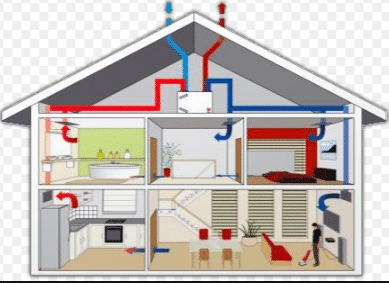A recent study published in the journal Building and Environment, has found that people working in green buildings; with optimum ventilation, lighting and heating controls; think better in the office and sleep better when they get home.
As well as in the work place, this ethos can be transposed to the home. A ventilation strategy is best considered at the earliest stage of design of residential dwellings. We are often called upon to advise best ventilation solutions, and asked to explain different systems on offer:
System 1 – Intermittent extract fans with background ventilators
This is the most common approach to meeting Building Regs Part F. Extract fans are located in bathrooms, kitchen, and utility rooms. These fans can operate in conjunction with light switch, remote switch, pull cord, humidistat, presence detector, or timer. They must comply with ventilation airflow rates set out in Part F, dependant on number of bedrooms and occupancy levels, ensuring that adequate air quality is provided indoors for occupants.
In addition, background ventilators (usually trickle vents) are fitted to windows to provide the whole building ventilation, and provide air to the extract fans, which will aid to remove odours and humidity.
This is the simplest system available, both to install, and for occupants to control. Fans though, must be regularly maintained, in order for best efficiency, and to reduce any potential noise issues.
System 2 – Passive Stack Ventilation
This is a non-mechanical system. Passive stack vents, in various locations throughout the dwelling, will extract any odours or moisture, using the principle of convection, via ducts. Trickle vents will allow the supply of air into the dwelling.
The system, although with no running costs, is dependent on local weather, which can provide risks of over and under ventilation.
System 3 – Mechanical Extract Ventilation
This is a system which covers continuous Mechanical Extract Ventilation (MEV). It is either a Whole House Centralised MEV system, or a Localised Decentralised MEV fan.
The centralised system is usually located in the loft, with ducts running from the unit to all wet rooms, controlling the humidity levels in these rooms, by drawing any moisture from the air.
The decentralised system contains separate fans in each room, again drawing moisture from any wet room.
Also with system 3, background ventilators will be fitted to all windows (except wet rooms).
The system is considered a more effective ventilation method, continually working at predetermined rates – these rates will be calculated according to tables available in Part F. There are potentially less ‘noise issues’ than system 1, as long as the duct work is installed efficiently.
System 4 – Mechanical Ventilation with Heat Recovery (MVHR)
Heat Recovery provides fresh, filtered air, energy efficiency and a comfortable all year round climate. The system runs continuously providing a constant flow of air. Extract fans extract any odours or moisture from the air of any wet room in a dwelling. This extracted air is passed over a heat exchanger, which then transfers the heat to the incoming air, to be distributed via ducts, to all other habitable rooms in the home. The flow rate is easily controlled, and boosted to relieve any higher levels of pollutants.
This is a more sophisticated ventilation method, and no trickle vents are required. Again, ducts have to be installed well in order to maintain efficiency of system.
There are also other systems of ventilation that are certified by the British Board of Agrement (BBA), most notably Positive Input Ventilation. This system controls condensation by diluting and replacing high humidity levels to control condensation. It is a sophisticated all year round system; highly efficient, benefiting from solar gain from the loft space to provide heat distribution.
For each of the ventilation systems to be effective, air must be able to flow through the dwelling. Part F make provision for this by having all internal doors undercut to keep a gap of 10mm above any finished floor surface.
Briary Energy are always available to advise on a solution that meets your need. Good indoor air quality is highly underrated, and as the recent study proved, can make you healthier, happier, brainier, and well rested. Sounds good to me….

